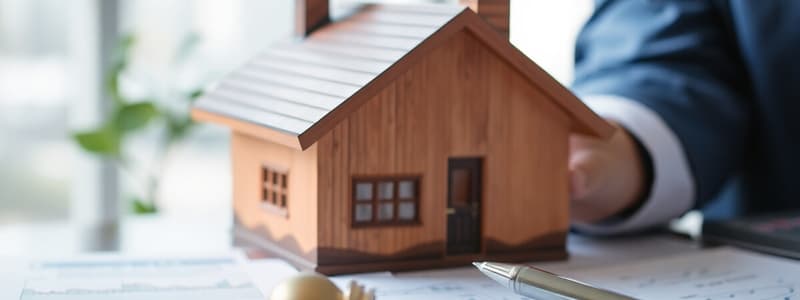Podcast
Questions and Answers
What is the primary outcome of the valuation process for real property?
What is the primary outcome of the valuation process for real property?
- A description of the property's features
- An opinion of market value (correct)
- A list of nearby comparable properties
- A history of the property's sales
What factors does the appraiser analyze when investigating market trends?
What factors does the appraiser analyze when investigating market trends?
- The local economy and seasonality
- The buyer's financial capability
- The principles, forces, and factors affecting value (correct)
- The construction cost and maintenance expenses
Which step is typically performed first in the valuation process?
Which step is typically performed first in the valuation process?
- Defining the appraisal problem (correct)
- Analyzing the gathered data
- Collecting property sales history
- Reporting the conclusions
The valuation process concludes when the appraiser:
The valuation process concludes when the appraiser:
What characterizes the valuation process regarding the nature of property?
What characterizes the valuation process regarding the nature of property?
Which option represents a common appraisal assignment?
Which option represents a common appraisal assignment?
During which phase does the appraiser start to gather necessary information?
During which phase does the appraiser start to gather necessary information?
In the valuation process, how does the appraiser support their value conclusion?
In the valuation process, how does the appraiser support their value conclusion?
What is the primary basis for the income capitalization approach in property valuation?
What is the primary basis for the income capitalization approach in property valuation?
Which of the following elements is crucial in the definition of the problem during the valuation process?
Which of the following elements is crucial in the definition of the problem during the valuation process?
In which situation would one or more of the valuation approaches be less applicable?
In which situation would one or more of the valuation approaches be less applicable?
What is the main focus of the sales comparison approach in property appraisal?
What is the main focus of the sales comparison approach in property appraisal?
What factor does NOT typically affect the reliability of a specific valuation approach?
What factor does NOT typically affect the reliability of a specific valuation approach?
Which valuation approach is commonly used for income-producing properties?
Which valuation approach is commonly used for income-producing properties?
What is included in the cost approach for property valuation?
What is included in the cost approach for property valuation?
Why is the identification of the client important in the appraisal process?
Why is the identification of the client important in the appraisal process?
What is the primary significance of analyzing the highest and best use of a property as improved?
What is the primary significance of analyzing the highest and best use of a property as improved?
Which of the following statements accurately describes the difference between land and site?
Which of the following statements accurately describes the difference between land and site?
Why is estimating the land's highest and best use as though vacant necessary?
Why is estimating the land's highest and best use as though vacant necessary?
What is a common reason why appraisers develop a separate opinion of land value?
What is a common reason why appraisers develop a separate opinion of land value?
Which of the following options is NOT a choice when determining the future of existing improvements?
Which of the following options is NOT a choice when determining the future of existing improvements?
What is one of the two reasons to analyze the highest and best use of a property as improved?
What is one of the two reasons to analyze the highest and best use of a property as improved?
Which approach is NOT mentioned as one of the important methods to determine property value?
Which approach is NOT mentioned as one of the important methods to determine property value?
What role does market analysis play in the valuation process according to the highest and best use analysis?
What role does market analysis play in the valuation process according to the highest and best use analysis?
What is primarily reflected by market value?
What is primarily reflected by market value?
Which scenario would most likely require a retrospective appraisal?
Which scenario would most likely require a retrospective appraisal?
When is a prospective appraisal typically necessary?
When is a prospective appraisal typically necessary?
Which item is essential to identify the nature of the property in an appraisal?
Which item is essential to identify the nature of the property in an appraisal?
Which statement about extraordinary assumptions is true?
Which statement about extraordinary assumptions is true?
Which of the following is NOT a characteristic that should be identified when appraising property?
Which of the following is NOT a characteristic that should be identified when appraising property?
What must appraisers avoid when providing an opinion of prospective value for property?
What must appraisers avoid when providing an opinion of prospective value for property?
What is the primary concern when evaluating market value at a specific time?
What is the primary concern when evaluating market value at a specific time?
What does yield capitalization primarily reflect in the appraisal process?
What does yield capitalization primarily reflect in the appraisal process?
Which of the following is NOT typically considered in the income capitalization approach?
Which of the following is NOT typically considered in the income capitalization approach?
What is the final reconciliation of value indications designed to achieve?
What is the final reconciliation of value indications designed to achieve?
What role does Discounted Cash Flow (DCF) analysis play in yield capitalization?
What role does Discounted Cash Flow (DCF) analysis play in yield capitalization?
Which of the following best describes the nature of the appraisal report as the last step in the valuation process?
Which of the following best describes the nature of the appraisal report as the last step in the valuation process?
Which statement accurately describes a possible conclusion of the appraisal?
Which statement accurately describes a possible conclusion of the appraisal?
In direct capitalization, which term describes the income projection used to estimate property value?
In direct capitalization, which term describes the income projection used to estimate property value?
What specific data might be integral in the income capitalization approach by an appraiser?
What specific data might be integral in the income capitalization approach by an appraiser?
What is the primary focus of the cost approach in property valuation?
What is the primary focus of the cost approach in property valuation?
Which of the following is NOT typically considered in the sales comparison approach?
Which of the following is NOT typically considered in the sales comparison approach?
In the income capitalization approach, which method is used to determine the present value of future benefits?
In the income capitalization approach, which method is used to determine the present value of future benefits?
What is included in the formula for determining property value using the cost approach?
What is included in the formula for determining property value using the cost approach?
Which element is LEAST relevant when estimating similarities in the sales comparison approach?
Which element is LEAST relevant when estimating similarities in the sales comparison approach?
How is depreciation measured in the cost approach?
How is depreciation measured in the cost approach?
Which characteristics are NOT included for comparison in the sales comparison approach?
Which characteristics are NOT included for comparison in the sales comparison approach?
In the income capitalization approach, yield capitalization is primarily focused on which aspect?
In the income capitalization approach, yield capitalization is primarily focused on which aspect?
Flashcards
Valuation Process
Valuation Process
A systematic process used by appraisers to determine the value of real estate.
Market Value
Market Value
The most common appraisal assignment, focusing on the price a willing buyer would pay and a willing seller would accept in an open market.
Research Phase
Research Phase
The initial stage of the valuation process, where the appraiser gathers and analyzes information relevant to the property and its market.
Market Trend Analysis
Market Trend Analysis
Signup and view all the flashcards
Factors Affecting Real Estate Value
Factors Affecting Real Estate Value
Signup and view all the flashcards
Approaches to Value
Approaches to Value
Signup and view all the flashcards
Opinion of Market Value
Opinion of Market Value
Signup and view all the flashcards
Appraisal Report
Appraisal Report
Signup and view all the flashcards
Date of Opinion of Value
Date of Opinion of Value
Signup and view all the flashcards
Retrospective Appraisal
Retrospective Appraisal
Signup and view all the flashcards
Prospective Appraisal
Prospective Appraisal
Signup and view all the flashcards
Value at the End of a Cash Flow Projection
Value at the End of a Cash Flow Projection
Signup and view all the flashcards
Characteristics of the Property
Characteristics of the Property
Signup and view all the flashcards
Extraordinary Assumptions and Hypothetical Conditions
Extraordinary Assumptions and Hypothetical Conditions
Signup and view all the flashcards
Highest and Best Use
Highest and Best Use
Signup and view all the flashcards
Highest and Best Use as Though Vacant
Highest and Best Use as Though Vacant
Signup and view all the flashcards
Restrictions on Land Use
Restrictions on Land Use
Signup and view all the flashcards
Highest and Best Use as Improved
Highest and Best Use as Improved
Signup and view all the flashcards
Land
Land
Signup and view all the flashcards
Site
Site
Signup and view all the flashcards
Land Value
Land Value
Signup and view all the flashcards
Cost Approach
Cost Approach
Signup and view all the flashcards
Cost Approach
Cost Approach
Signup and view all the flashcards
Sales Comparison Approach
Sales Comparison Approach
Signup and view all the flashcards
Sales Comparison Approach
Sales Comparison Approach
Signup and view all the flashcards
Income Capitalization Approach
Income Capitalization Approach
Signup and view all the flashcards
Income Capitalization Approach (Dominant)
Income Capitalization Approach (Dominant)
Signup and view all the flashcards
Definition of the Problem
Definition of the Problem
Signup and view all the flashcards
Identification of the Client & Users
Identification of the Client & Users
Signup and view all the flashcards
Intended Use of the Appraisal
Intended Use of the Appraisal
Signup and view all the flashcards
Date of the Opinion of Value
Date of the Opinion of Value
Signup and view all the flashcards
Current Cost of Constructing Improvements
Current Cost of Constructing Improvements
Signup and view all the flashcards
Depreciation
Depreciation
Signup and view all the flashcards
Comparable Sales
Comparable Sales
Signup and view all the flashcards
Elements of Comparison
Elements of Comparison
Signup and view all the flashcards
Direct Capitalization
Direct Capitalization
Signup and view all the flashcards
Yield Capitalization
Yield Capitalization
Signup and view all the flashcards
Discounted Cash Flow (DCF) Analysis
Discounted Cash Flow (DCF) Analysis
Signup and view all the flashcards
Capitalization Rate
Capitalization Rate
Signup and view all the flashcards
Income Multiplier
Income Multiplier
Signup and view all the flashcards
Reconciliation of Value Indications
Reconciliation of Value Indications
Signup and view all the flashcards
Report of Defined Value
Report of Defined Value
Signup and view all the flashcards
Study Notes
Introduction to Valuation Process
- The valuation process is a systematic procedure appraisers use to answer client questions about real property value.
- It's adaptable to various value-related questions.
- It's a systematic and logical process for gathering, analyzing, and processing data into well-reasoned value estimates.
- The process begins when an appraiser accepts an assignment and ends when appraisal conclusions are reported to the client.
- Each property is unique, leading to multiple value opinions.
- The most common appraisal assignment is determining market value.
Steps of the Valuation Process
-
The process involves specific steps.
-
The number of steps depends on appraisal details and available data.
-
Research begins after defining the appraisal problem and scope of work.
-
Research involves gathering necessary information to support the valuation.
-
Data analysis starts with an investigation of market trends (international, national, regional, or neighborhood).
-
Analyzing trends helps understand relationships among principles, forces, and factors affecting real property value.
-
Trends often include positive or negative changes in property value over time.
-
Appraisals aim for a well-supported value reflecting all pertinent market factors.
-
To determine value, appraisers consider properties from three perspectives:
- Cost approach: Value estimated as current replacement cost minus depreciation plus land value.
- Sales comparison approach: Value determined by recent sales of similar properties.
- Income capitalization approach: Value based on a property's earning power.
Step 1: Definition of the Problem
- Defining the problem involves identifying the client and intended users of the appraisal.
- It determines if the appraisal is relevant, unbiased, and meets the specific needs of those involved..
- It includes the intended purpose (and definition of value), date, location, property characteristics, and property rights.
- The characteristics include extraordinary assumptions and hypothetical conditions.
Step 2: Scope of Work
- The scope of work defines the amount and type of information researched and analyzed in an assignment.
- The appraiser determines the appropriate scope based on the client's intended use and the nature of the problem.
- The scope must be clearly disclosed in the appraisal report. The report should also indicate what aspects were not considered.
- The appraiser should describe the time spent, area searched, and data availability during the project.
- Use a separate section within the report to define the scope of work.
Step 3: Data Collection and Description
- After preliminary analysis (scope of work), the appraiser gathers data on the market area, subject property, and comparable properties.
- Data is categorized as general or specific.
- General data includes information about social, economic, governmental, and environmental forces affecting property value in the area.
- Specific data details the legal, physical, and locational characteristics, cost information, and comparable sales details.
- Financial data affecting selling prices is also considered.
Step 4: Data Analysis
- Once data is reviewed for accuracy, analysis begins.
- Two key components: market analysis and highest and best use analysis.
- Market analysis examines market conditions for the specific property type, considering local and neighborhood influences.
- Market analysis helps understand overall trends in property valuation.
Step 5: Land Value Opinion
- Land valuation directly relates to highest and best use analysis.
- Land includes the earth's surface and attachments (water, etc.).
- Site refers to improved land.
- Both land value and property value can be important components.
Step 6: Applying the Approaches
- The cost, sales comparison, and income capitalization are important methods for determining property value.
Step 7: Final Reconciliation
- This step reconciles various value indications into a single figure or range.
- The nature, approach used, and reliability of value indications influence the reconciliation process.
Step 8: Reporting Defined Value
- The assignment is complete after the conclusion is clearly reported and presented to the client.
- The reported value represents the appraiser's opinion, reflecting accumulated experience.
- The report should include a final appraisal opinion or range of values.
Additional Considerations
- Appraisal reports should include the information needed in the tangible evaluation process.
- Findings and conclusions can be communicated to the client orally or in writing.
- Factors considered might include unusual property characteristics or the lack of market data.
- Appraisals based on hypothetical situations are valid but are specifically disclosed.
Studying That Suits You
Use AI to generate personalized quizzes and flashcards to suit your learning preferences.



